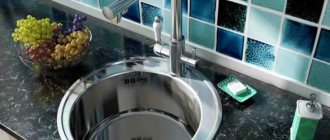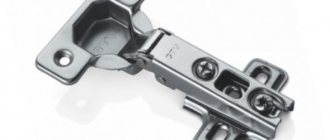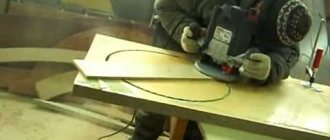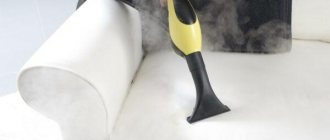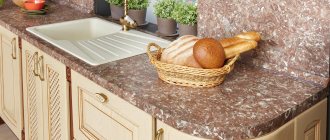Kitchen sinks differ in material, size, shape, design and installation method. Overlay models are considered outdated against the background of a variety of fashionable mortise products. However, they have a number of advantages for self-installation and are still used in summer cottages and temporary apartments.
In this article, we will look at how to install an overhead sink with your own hands, what needs to be prepared for this, and what installation methods are best to use. To make it easier for you to understand the main stages of installation, we have selected visual photos and useful video recommendations for installation.
Types of products and installation methods
There are several options for installing a sink into a countertop. The choice of installation method depends on the design features of the sink. The most common types of sinks are:
| Types of products | Advantages | Flaws | Installation principle |
| Invoices | Budget price category. Easy to install. | Small material thickness. Formation of a gap between the countertop and the sink. | The sink is placed on a free-standing cabinet so that it becomes an extension of the worktop in the kitchen. |
| Mortise | Ease of use. Practicality and durability. | High price. | Inserting the sink into the countertop, into a specially made hole, provides for fastening with clamps and brackets to the inside of the module. |
| Under-desk | Aesthetic appearance. Noise insulation. Durability due to reliable sealing of joints. | Inaccessible due to high cost. Not suitable for all countertop materials. | The sinks are mounted in a cut-out hole, but are fixed below the countertop, forming a single whole with it. |
Overhead two-section sink Source vseme.ru
Kitchen sinks are traditionally made from stainless or enameled steel, as well as from artificial stone and composite materials, which are resistant to external influences and sudden temperature changes.
What material are sinks made from?
Quite often, choosing a kitchen sink becomes a difficult task. Errors in operation lead to the fact that products have to be constantly changed, so it is necessary to familiarize yourself in advance with some of the features of each material.
Table No. 3. Materials for making modern sinks
| View, illustration | Description |
| Stainless steel | Often used in the production of sinks. Products come with a rough, matte and glossy texture. The main advantage of the material is its low price. In addition, even a beginner can handle installing such a sink without fear of damaging the surface. Metal products have an aesthetic appearance, thanks to which they fit perfectly into the interior of various kitchens. In addition, stainless steel does not suffer from exposure to various chemicals. The only disadvantages that can be highlighted are the possibility of scratches and dents. |
| Ceramics | Washbasins of various types are often made from this material. At the same time, the main advantage of ceramic products is their attractive appearance. Such designs are especially suitable for kitchens of classic design. In addition, such a surface is not damaged when exposed to hot water or aggressive alkali, and there are very rarely scratches on it. Another clear advantage is the ability to install the sink yourself without the help of a specialist. One of the disadvantages is the fragility of ceramics - this means that the sink can break with a strong impact. |
| Fake diamond | This is the most modern material that is actively used for the manufacture of sinks. It is based on natural and synthetic components. The first option has a higher cost, it is resistant to various damages and chemicals. The main advantages include a variety of colors. |
How to install a countertop sink
The method of installing overhead products has its own peculiarities. The sink is mounted on a separate kitchen module so that its upper part is completely covered. This work is usually not difficult even for beginners. The sink is fixed using L-shaped elements with oblique slots.
Before installing an overhead stainless steel sink on the cabinet, you need to complete the following preparations:
- Purchase at least 4-5 parts for fastening, as well as 15 mm self-tapping screws.
- Connect the mixer in advance.
Instructions for installing an overhead sink:
- Take the prepared fasteners. Attach them to the inner surface of the cabinet. Place marks.
- Focusing on the markings, tighten the screws. They should be located 5 mm above the markings.
Installation on a wooden frame Source remontkit.ru
Treat the end part of the cabinet with sealant. This will make the sink mounting location more reliable and protect it from moisture and dirt.
Place the product on the screws. Before attaching a stainless steel sink to the countertop, you need to check that it fits as tightly as possible to the cabinet.
Fasten the fasteners firmly. If excess sealant appears, clean it from the cabinet. Connect the water supply.
See also: Companies specializing in decorative forms and engineering communications.
Conclusions and useful video on the topic
Video instructions for installation on a kitchen sink:
An overhead sink is not the best solution for improving the kitchen. But when a suitable cabinet is idle at the dacha and you need to quickly create comfortable living conditions, it is considered one of the most successful options. It is also attractive that installation work does not require special skills, time and effort - everything can be done with your own hands.
Would you like to supplement the step-by-step instructions outlined above with useful tips or point out nuances that we did not mention? Please write your comments and recommendations under this article.
Or maybe you want to share your personal experience of installing a sink in your dacha? Tell us how difficult this work was for you and how much time it took you to assemble the structure.
Mounting a mortise sink
Inserting a sink into a countertop involves a number of successive steps.
Preparing materials and tools
Before proceeding with the installation of the sink, check the complete set of the sanitary ware. The kit must contain all the necessary fasteners and seals. You should have on hand: silicone sealant, tape measure, level, Phillips screwdriver, screwdriver, electric jigsaw, drill.
Carrying out markings
The method of applying markings on the tabletop depends on whether the kit includes a cardboard template. Its presence greatly simplifies the work. The outer and inner contours of the sink are cut out using the template. Then it is placed on the tabletop, secured with tape and outlined with a pencil.
The template is applied to the upper surface of the tabletop Source remontu.com.ua
If the template is not included, marking the hole is a little more difficult. First, trace the edges of the sink, positioning the sink so that its bowl faces down. Then the sink is turned over and placed on top of the countertop in the same way as it will be installed when finished. Secure with tape. Align and trace the outline. The correct installation of the product and the ease of its operation depend on how accurately the markings are made. A cutting line is drawn inside the contour.
To make markings, it is better to use a pencil Source berkem.ru
Cutting a hole
Before cutting a hole for the sink in the countertop, take an electric drill and make 2-3 holes one after another on the cutting line to create a single gap. Its length should be such that an electric jigsaw can easily fit inside. With its help, slowly and very carefully cut out a hole.
If the jigsaw deviates a little from the marking line, it’s okay. A discrepancy of 2-3 mm is allowed. The cut site is cleaned of dust and the product is “tried on”. It should fit freely into the hole, but not cling or “walk around”. If the shell does not fit completely into the hole, it is slightly widened using a jigsaw.
The tabletop should not be turned over from the front side during cutting, otherwise chips may form. Source stopdacha.ru
Detailed installation instructions
Let’s look at how you can independently install an overhead sink from “A” to “Z” without resorting to the services of hired installers and furniture manufacturing companies.
The instructions will be useful to anyone who is used to doing all the simple housework with their own hands, and the sink itself will find a place in a country house or in an apartment kitchen as a temporary replacement.
Step #1 - selection of materials and tools
To assemble more quickly, the cabinet can be purchased ready-made, but only if it is sized to fit the sink.
The second solution is to order from a furniture company, but this option is only advisable if the cost of the order is low.
One of the finished product options. However, a self-made cabinet has a significant advantage - an individual design, selected for a specific interior.
To put together a cabinet and attach a sink to it, you will need the following materials:
- thin boards, sheets of chipboard or MDF plywood;
- steel sink;
- kitchen faucet with hoses;
- fastenings for washing (screws, corners);
- sealant or polyurethane foam;
- hinges and handle for the door;
- siphon with sewer fittings;
- antiseptic impregnation;
- legs or rollers.
To attach the sink to the cabinet, you only need a screwdriver or a screwdriver to tighten the screws, but to cut out the walls, base and door you will need a hacksaw, circular saw or jigsaw.
When using power tools, which significantly reduce the number of chips when cutting chipboard, it is recommended to use guides so that the lines are perfectly straight
To clean the ends, you will need sandpaper, and to drill holes for self-tapping screws, a drill with a thin drill bit. We do not recommend using nails: they are more difficult to hammer into particle board panels, and besides, the structure fastened with nails becomes inseparable.
It is better to purchase all materials in advance so as not to waste time searching for the necessary parts during the assembly process. The listed tools are usually found in the home workshops of amateur craftsmen, especially if they are in charge of a dacha farm.
Step #2 - making a kitchen cabinet
The sink cabinet has a design that differs from conventional kitchen cabinets. It does not have two elements: a back wall - for free connection to communications, as well as a countertop, since it is completely replaced by an overlay sink.
A drawing with dimensions can be taken in the public domain, although there are universal parameters: height - 850 mm, depth - 600 mm, width - 500-600 mm. The finished model is also suitable as a sample.
Sheets of chipboard, thick plywood or moisture-resistant plasterboard - sometimes it’s easier to take some materials left over after repairs - we take in such a volume that there is enough material for two full walls, a bottom and parts for the connecting “belt”.
Procedure:
- first we cut out the large elements - two identical side walls and the base, then - the horizontal connecting parts;
- We carefully cut and, if necessary, clean and process the edges;
- if we use planed boards or plywood, before assembly we cover all elements with antiseptic impregnation, varnish or paint;
- we connect the elements according to the drawing using self-tapping screws and metal corners;
- Attach legs or rollers to the bottom side of the base.
If possible, we adjust the legs. If desired, the space under the cabinet can be covered with a plank. Lastly, we hang the door. This is best done after installing the sink.
To attach the hinges, take a drill with a bit of suitable diameter and drill two holes - top and bottom. We try to ensure that the crown does not penetrate right through the panel.
It is recommended to place drawers (transverse stiffeners) directly under the sink and at the very bottom. You can also make additional crossbars in the middle if the structure is voluminous.
Having assembled the structure, we check its strength. We install it at the chosen location - it is desirable that it is as close as possible to communications.
Step #3 - choosing a suitable sink
Metal overhead sinks are sold in plumbing stores and can also be found in garden departments. They are similar to each other, but may differ in design and size.
In addition to single sinks, which are a traditional rectangular or square product with rounded corners of the bowls, there are models with drying shelves on which it is convenient to stack washed dishes, vegetables or fruits.
When choosing the size, you need to take into account the dimensions of the cabinet, if it is already ready. Otherwise, the sink is chosen according to needs: single or double, with or without a drainer.
If you need to soak dishes, it is better to purchase a sink with two compartments. It will also be appropriate for large families, when an additional compartment is needed to accommodate a large volume of dishes or wash vegetables.
Check if there is an overflow in the bowl - insurance against flooding, as well as a round grate for the drain hole, which traps large debris and food debris
The metal from which the sink is made can be shiny (traditionally “steel”) or matte. In terms of technical characteristics, both options are the same.
Next, we’ll look at how best to attach an overhead sink to a kitchen cabinet.
Step #4 - installation of faucet and siphon
Once the cabinet is assembled and adjusted, the hardest part of the job is over. All that remains is to fix the sink, having previously fixed the mixer and siphon to it.
First, you can install the mixer using the fasteners and gaskets included in the kit.
If you do not have experience installing a faucet in the kitchen, then it is advisable to look at the installation diagram given in the user manual. In the figure: 1 - elements for fastening; 2 - mixer with flexible hoses; 3 - connecting the tap to the sink; 4 - mixer is securely fastened
If only cold water supply is available at the dacha, then instead of a mixer, install a simpler device - a single tap for cold water.
Next you need to install a siphon. It is necessary to prevent odors from the sewer pipe from spreading throughout the living quarters.
It is also advisable to attach it to the bottom of the sink before installation, but it is also possible after - there is enough space under the sink to manipulate the plastic fittings.
Thanks to the prefabricated design, plastic siphons are installed quickly - according to the scheme proposed by the manufacturer.
Before attaching the sink, it is recommended to first install the siphon and mixer, since all procedures are much easier and faster
Step #5 - installing the sink on the cabinet
Often, to install metal sinks, plastic “corners” are used - L-shaped pads, which are fixed to the upper ends of the side walls.
Elastic plastic helps the sink “sit” in place. During operation, it does not suffer from friction, but it holds firmly and does not move when washing large dishes.
If the sink and cabinet fit perfectly in size, linings, screws or other fasteners do not need to be used.
Before installation, sealant is applied to the edges of the cabinet, after which the edges of the sink are pressed tightly against the walls and partitions.
It is recommended to use silicone sealant designed for use in microclimates with high humidity. It will last much longer and withstand the load during operation
When using any adhesive, you should remember that a permanent connection is created, although with a certain force it will still be possible to tear the sink away from the cabinet.
When planning the installation of the door, you need to make sure that it opens freely without touching the front edge of the sink, which will be lowered by several centimeters.
The process of installing a sink is simple and takes a minimum of time if it matches the size of the cabinet.
Step #6 - connecting to communications
Without a connection to the water supply and sewerage system, the sink is unusable, so the final stage is connecting the plumbing fixtures.
First we connect to the water supply network. The mixer has already been installed - all that remains is to connect two flexible hoses. They lead from it to tees embedded in water pipes.
When connecting to the water supply network, the fasteners must be securely tightened, ensuring the connection assembly is leak-tight. It is convenient to work with flexible eyeliner, so even a beginner can cope with the task
Next, it remains to connect to the drainage system by connecting the outlet pipe - a pipe connected to the outlet of the siphon - with a sewer pipe.
Most often, corrugation is used for assembly, but it traps debris and sags over time.
If you need to increase the outlet to the sewer for waste from the sink, it is better to use flexible hoses with a smooth inner surface or plastic pipes
After installing and connecting the mixer and siphon, turn on both taps and check the functionality of all devices.
Upon successful completion of the work, the door is hung at the very end - this completes the installation of the sink.
Video description
Watch the video on how to embed a stainless steel sink into a countertop:
Connecting communications
At the final stage, communications, cold and hot water are supplied to the plumbing product. First, use a fixing screw and a rubber seal to secure the tap. Experienced craftsmen assemble the faucet before cutting out the countertop for the sink, connect hoses to it and fix it to the bowl.
Water hoses are pulled to the water supply system. Check the reliability of all connections. If necessary, use fum tape. Start the siphon and connect it to the drain corrugation.
After the communications are connected, it is important to check whether there will be a leak Source rudmar.ru
Method of attaching an overhead sink
The peculiarity of an overhead sink is that it is not fixed to the countertop, but is placed on a cabinet of the appropriate size. If you pay attention to the inside of the sink, you will see that the structure has the appearance of a rack profile - it is to this that you will have to attach the fasteners.
Fastening elements for overhead sinks
Step-by-step instruction
Step 1. It is necessary to make preliminary markings for fasteners on all four sides.
Marking fasteners
Step 2. From below, the edge of the fastening element is attached to the wall of the cabinet using screws. At this stage it is important to ensure that they do not stick out.
Installation of fasteners
Next, you will need to install fasteners on all sides and make sure they are strong. In addition, you should attach the faucet to the sink.
Professional advice on installing sinks: what to look for
Experienced installers share the following secrets of their work:
- When installing a mortise sink yourself, you need to check the dimensions of the hole several times. It should not be too large, otherwise the sink will “walk” in the groove and the fastenings will not provide the required strength.
- When installing a stainless steel sink, do not overtighten the screws. This may cause damage.
- Instead of the seals that come with the sink, you can use sealant. You shouldn't save it. It’s easier to carefully remove excess than to deal with leaks later.
- When using a screwdriver, it is important to be careful not to bend the hardware. If you don’t have much experience with this tool, you should give preference to a Phillips screwdriver.
Silicone sealant should be checked for hardening speed before use. Source mtdata.ru
Method of attaching an undermount sink
Sinks of this type are installed below the table through a seal. On one side, the fastening element grips the countertop, and on the other, the edge of the sink itself.
The structure is securely fixed thanks to screws that are attached to the inside of the sink. For a table made of wood it should be a screw, for stone it should be a screw and a dowel.
Under-table sink mounting diagram
Installation features depending on the shape and material of the sink
The insertion process may have its own nuances depending on the selected sink material and its shape.
Installing a corner sink
An important point when installing such a product is cutting out a right angle. In order for an electric jigsaw to easily pass through the corners of the tabletop, several holes are first made in them with a drill, one after another, and they are combined.
You should also pay attention to the fact that the corners of the sink and the connection lines between the inner and outer corners of the cabinet coincide.
Installing a square sink
Installing a sink into a countertop begins with drawing a line that runs parallel to the edge of the countertop. Then make an indent to the width of the sink and draw a second line. In a similar way, two perpendiculars are measured and laid.
Mark the intersection point of the segments that connect opposite angles. The siphon is located in this place.
Square shaped sink Source userapi.com
Installing a stone sink
Sinks made from natural stone, such as granite, do not have faucet or drain holes. The first can be mounted separately to a tabletop or adjacent wall. And it is impossible to do without a siphon.
Carefully making such a hole in a natural stone sink yourself, without sufficient knowledge and experience, is a very difficult task. For this you need an electric drill with diamond bits. For this reason, it is better not to install expensive granite sinks yourself, but to trust specialists.
Rules for installing a countertop kitchen sink
Before starting installation work, it is worth deciding on the place where the structure will be built. Usually it is tied to sewerage and water supply. However, modern technologies make it possible to embed the device anywhere in the headset. When choosing an installation location, it is advisable to follow these recommendations:
- The bowl is placed as close to the work area as possible, making it more convenient to cook.
- The design divides the work surface into two parts: dirty and clean. In the first, food is processed, in the second, they are served.
- The sink should not be placed near the stove or refrigerator. It's not practical.
- It is advisable that there be light where the bowl will stand. If necessary, additional lighting is provided.
For a functional kitchen, it is best to choose a deep appliance: you can wash large dishes and other large items in it. It is worth choosing a low mixer - this combination will give a minimum of splashes during operation.
Video description
Watch the video on how to embed a stone sink into a countertop:
We install ceramic products
Ceramic sinks have the following feature: one part of the sink is overhead, the other is cut into the countertop. Such models are fastened using a combined method. To ensure the reliability of the structure, both sealant and mechanical fixing devices are used.
In addition, to secure the sink, load-bearing structures are made from wooden blocks. You can do this yourself. Wood should be treated with antiseptic agents.
Products made of ceramics and natural stone are very heavy, so when installing them, durable countertops and cabinets are required Source www.build2last.ru
3 more important tips
Do you want to connect the sink yourself correctly? Don't forget 3 more points:
- It is better to replace rubber seals with silicone sealant. Rubber will not provide a tight fit and does not have a sufficient service life, while the sealant will fill all the gaps and cracks;
- It is better to connect sinks made of natural or artificial stone together to prevent falls and damage;
- Fastening the sink to the countertop or module with self-tapping screws is carried out exclusively by hand. Using a tool may create too much tension, which may damage the structure.
Specifics and models of wall-mounted sinks
The latest modern trend in sink installation is to mount the unit to the wall surface. This type of arrangement is one of the most familiar and favorite among Russians, since this type of installation has worthy and significant advantages. By installing the sink on the wall, you will save the desired meters of space, and the space under the sink is very convenient to use and keep clean.
Hanging washbasins save space in the bathroomBefore you begin installation work, choose the model of wall-mounted sink that has the most ergonomic design. A separate model has specific design aspects, which, of course, affects the method of its installation. Therefore, it is so necessary to have at least some knowledge about the installation and specifics of connecting the device to the general water supply system.
A wall-hung sink above the washing machine is an excellent solution for a small space
An interesting solution is to install a sink above the washing machine; this saves precious space in the bathroom.
Slice processing procedure
Experienced experts advise: since in the process of creating a hole along the inner edge of the cut, roughness and small chips often form, you need to become familiar with the rules for processing the cut, failure to comply with which leads to a number of problems:
- Since it is impossible to ensure absolute sealing of the unprotected surface of the chipboard, its insufficient degree causes moisture to penetrate into this part of the tabletop. As a result, decay processes may be activated and a fungal coating may appear.
- Subsequently, the cutting edge becomes fragile and the stability of the shell decreases, which ends with its distortion.
- As a result of rotting of the countertop, its aesthetic, strength and performance qualities are reduced and then replacement will be required.
To prevent the above-described troubles, you should:
- Treat the end surface of the cut with fine-grained sandpaper and treat it with high-quality plumbing sealant. Professionals recommend using a spatula to perform this work; in the absence of which, the composition can be applied with your finger. Carrying out protective measures helps prevent wetting and subsequent swelling of the surface of the cabinet.
- If, when performing work such as cutting out a sink in a countertop, chips are found on the front side of the plastic, they are carefully treated with sealant, and there is no need to apply it in a thick layer, since in this case the thickness is not important.
- There is another way to protect the end side of the cut - it involves treating it with PVA glue. Despite the laboriousness of this process, it is reliable, like the previous option. To enhance the protection effect, the applied layer of glue should dry for about 30 - 50 minutes.
- Next, you should glue the seal made of foamed polyethylene; it is usually included with the sink. This material is fixed on the side of the sink along its perimeter. When, after attaching the seal, it can be seen, the material is carefully trimmed with a knife. If this is not done, the edges of the sink will not fit tightly to the countertop and water, getting into the gaps created, will cause swelling and further rotting of the end.
Since the process of attaching the seal directly affects the performance and wear resistance of the kitchen set, attention should be paid to it:
- You need to take the material and degrease it with a rag soaked in gasoline and solvent.
- Then sealant is applied to the seal in a continuous thin strip so that the glue does not come out when compressed and pressed against the outer edge of the sink.
Kinds
There are several types of sinks, differing from each other in shape, size and functional features.
Classic wall
The most common and universal option. This design can be hung in both the family bathroom and the guest bathroom. The classic sink does not require a base for installation - it is mounted directly on the wall. The design looks especially elegant on a thin pedestal.
Tulip shells
This design is a regular sink mounted on a pedestal leg. The pedestal has two functions - it serves as a solid base for the washbasin, and also hides water and sewer pipes inside.
For furniture
Furniture sinks are designed for installation on a cabinet, table, or other pieces of furniture. In addition, they can cut directly into the surface. Structures are divided into overhead and built-in. The main advantage of such a washbasin is a significant saving of space in the bathroom, since the sink is installed directly on the furniture, which carries its own functionality.
Corner
A corner sink, as the name suggests, is located in the corner of the room. Due to its shape and location, this design effectively uses the bathroom space, since the corner of the room often remains unused. Corner washbasins come in both classic - wall-hung and built-in furniture, as well as in the form of a tulip with a support leg.
With cabinet
A cabinet with a sink is a ready-made design option that combines the functional features of a cabinet and a washbasin. This is a convenient and practical option that saves space in the room. The cabinet is suitable for storing linen, perfumes, and cleaning products.
The design can have different shapes - it can be angular or straight. There are wall-mounted sinks with a cabinet that are mounted on the wall. This design allows you to protect furniture from the accumulation of water at the bottom. There are also cabinets with a plinth - they cannot be turned over and do not require additional fastening.
Support the workpiece from the reverse side
Regardless of the type of drill bit, when metal penetrates wood, the unsupported wood fibers on the back of the workpiece are torn, resulting in chips. Therefore, you should not forget to support the back side of the material with a trim
boards. The backing scrap supports the fibers where the drill exits and prevents a sharp increase in feed at the end. When making holes on a drilling machine, simply place the scrap under the workpiece, and when using an electric drill, secure it with clamps. If at the beginning of drilling the fibers around the hole rise or small chips form, apply masking tape to the surface, and then mark the center and start drilling.
How to cut a hole
After the marking has been made, the hole needs to be cut. It should be accurate, but slightly larger in diameter than the sink bowl so that the sink can easily fit into it. To do this, you need to step back a couple of millimeters from the inner contour to the outside and make a cut along this line. This way you can achieve the necessary backlash.
Installing an undermount sink in the kitchen
You can use a jigsaw or drill to cut the hole. It will take longer to tinker with a drill, but this work is much easier to do with a jigsaw.
Shell material
The choice of material from which the sink is made should be approached with no less responsibility. Stores offer a wide range of products, from which you need to choose wisely
Experts recommend paying attention to products made from:
- of stainless steel;
- artificial stone;
- ceramics.
Cheap products quickly become unusable, requiring additional money for repairs or complete replacement.
Stainless steel
The choice of most buyers who want to install a high-quality and inexpensive product in the kitchen. Advantages of the material:
- light;
- does not deform when temperature changes;
- insensitive to moisture and steam;
- costs less than its competitors.
The only drawback is the ordinary appearance, which does not give the interior any individuality.
Fake diamond
The artificial stone used in the manufacture of kitchen sinks includes:
- stone chips;
- dyes;
- polymers;
- natural ingredients.
The advantages of the material include:
- strength;
- a variety of shapes and colors, allowing you to give the kitchen individuality;
- Dirt does not accumulate on the surface of the sink, since the material does not have pores;
- dampens noise from water due to its massiveness.
There is only one drawback - cost.
Ceramics
Ceramics is something between stainless steel and artificial stone, harmoniously combining their positive qualities. Advantages of the material:
- noiselessness during operation;
- attractive appearance;
- easy to clean;
- resists moisture, temperature changes and chemicals well.
Minuses:
- price;
- product weight.
Rules for working with a jigsaw
To understand how to properly saw a circle in wood, it is important to study the features. This carpentry tool helps to cut out ovals, wavy patterns, figures with uneven outlines, non-standard carved boxes, shelves with end-to-end patterns
To ensure that interaction with a jigsaw is organized and safe, it is important to adhere to the following rules:
In order for work with a jigsaw to proceed quickly and safely, do not forget to fix the product before work.
- To avoid inconvenience, special stands should be prepared during work. A slot is made up to the middle of the support, somewhat reminiscent of a lock hole.
- The stand is fixed with clamps or screws to the workbench.
- At the time of work, you need to sit down, position the file strictly vertically relative to the floor and perpendicular to the surface.
- The workpiece is placed in the middle of the stand, holding it with your left hand; you can saw the plywood with your right hand. The location of the cuts should be in the middle part of the support hole.
- The tool does not tolerate strong pressure: just a small touch and gradual movement up and down, and it will begin to work effectively.
Attributes:
- pencil;
- drill;
- drill;
- jigsaw
Selecting a location
First you need to find a suitable place to install new equipment.
Where not to place
Experts recommend that before installation you familiarize yourself with the places where you definitely cannot install an electric refrigerator.
Under the window
If you study the manufacturers' requirements for the use of equipment, you will notice that many of them do not recommend placing it under windows. The body of the device should not be exposed to direct sunlight, as this will cause it to deteriorate.
Near a heat source
There are several heat sources that refrigerators cannot be installed near.
Battery
In an apartment or private house where there is heating, special batteries are installed. Some people decide to place household appliances near them, but this should not be done. Under the influence of high temperatures, the housing will begin to quickly collapse.
Radiator
In many apartments you can see heating radiators on the walls, which are responsible for heating the room. In winter they are hot, and therefore it is better not to place anything near them.
Oven
In some kitchens, in addition to gas stoves, there are special ovens used for preparing baked goods. During operation, such ovens generate a lot of heat, and therefore it is contraindicated to place refrigerators near them.
Plate
The stove is an indispensable device in the kitchen, as most dishes are prepared with its help. Refrigeration equipment should be located at a distance of 100-120 centimeters from the gas stove.
Other
There are other appliances that can generate heat during operation. These include convectors, infrared heaters, heating stoves, and electric stoves.
Next to the sink
Some people decide to place the refrigerator close to the sink. Experts do not recommend installing it in this location due to the following factors:
- high humidity, due to which the case will quickly deteriorate;
- high probability of water getting on equipment.
When choosing a suitable location, you need to consider the location of the outlet. Equipment must be connected to grounded sockets that are connected to special stabilizers. They help equalize the voltage and prevent the connected refrigerators from burning out.
When choosing a place to install a refrigeration chamber, pay attention to the features of the floor covering. It must be smooth and highly durable
If the floor is uneven, you will have to install special pads under the legs of the device so that the body does not wobble.
Installation of an integrated sink
Installation of a sink made of acrylic stone or quartz agglomerate, made according to individual drawings, is carried out under production conditions.
There are 2 types of integrated sinks:
- bottom mounting, with a slight overhang of the countertop over the sink;
Sinks made to order from countertop material are visually very attractive. There are 2 important points to consider. The corners and edges of sinks cannot be rounded, which complicates maintenance. The design of the sink is not monolithic, like factory sinks, but is glued together from segments, which makes it less durable. This type of washing requires careful operation. Increased load should be avoided. The installation of a waste shredder that creates vibration is highly undesirable.
Under-table mounting
This method implies that the countertop will be higher than the edges of the sink. The installation method is used for furniture made from expensive materials. This allows you to achieve an attractive, sophisticated and strict look.
To perform such an installation, you need to buy a special sink designed for under-table installation. The sink is secured with screws or brackets.
In the case of the most expensive products, special self-tapping screws are included.
A special tool is usually used to cut a hole in the tabletop, but you can also use a regular jigsaw with diamond blades. The edges must be sanded and impregnated with moisture-repellent agents or covered with a special film.
Without the skills to perform such work, it is quite difficult to install an undermount sink. It is advisable to call a professional.
Please note the following during installation:
- You need to buy an undermount sink and the tools to install it.
- If you make a mistake when cutting a hole, the tabletop will most likely be damaged. After this, only the countertop sink can be installed.
The simplest method of installing such a model involves cutting the hole from the inside. The main thing is not to make mistakes in measurements. The sides of the kitchen sink should be flush with the opening. It is unacceptable for them to protrude or relapse.
Marking
The sink should be centered in the middle of the depth of the countertop, shifting to the left and right for the most convenient location. The distance from the side of the sink to the edge of the countertop should not be less than 50–70 mm, otherwise the sink should be moved slightly deeper. It is not recommended to make an indentation from the corner plinth less than 30–40 mm, otherwise it will be difficult to wipe the surface in this place. When installing a sink in a corner section, it is useful to leave a space of 100–140 mm from both walls in order to obtain a small space for convenient placement of household chemicals and cleaning accessories.
If there is no template, the sink must be turned over and installed on the countertop, carefully observing the indentations. The sink should be outlined in a circle with a water-soluble marker and removed, and then the contour line should be shifted inward by the width of the side. If the bowl does not follow the external contours, which is the case in sinks with a drying tray, the marking lines must be shifted a certain distance on each side. If two sinks or a waste compartment are combined in one block, a common hole is cut for them.
Step-by-step equipment installation technology
The problem of how to install a sink with a pedestal is solved quite simply.
The work is carried out in stages:
The bowl is then inserted into the pedestal and leaned against the wall, with the marked line and the top edge of the hardware aligned. A pencil is inserted into the holes on the back of the device and places for fastenings are marked.
A level is necessary for proper installation of the sink
- Preparing holes. Using a puncher or drill, holes are made whose diameter is slightly smaller than the diameter of the dowels. A little glue is poured into the prepared holes for a stronger connection, and the spacer dowels are driven in.
- Preparing the base for the pedestal. The floor must be perfectly level, otherwise the equipment will wobble. If necessary, you will have to level the surface with a solution.
Sink installation. Plumbing self-tapping screws are screwed into the prepared holes. The shell bowl is placed on them. We install it on a pedestal, making sure that the drain hole is located exactly in the center of the structure
We put spacer washers on the screws and carefully screw the structure to the wall
Do not overtighten the nuts: the shell may burst. It will be enough to tighten the washers so that the bowl does not wobble. Tightened nuts are covered with decorative plugs
- Siphon installation. The outlet element is connected to the sink. A mesh with a gasket and a screw is inserted into the drain hole. Installation of the outlet must be carried out with the installation of gaskets, which must fit tightly around the sink drain without the slightest gaps or displacements. We tighten the screw and connect the siphon to the outlet, after which we fix the outlet pipe in the sewer socket.
- Mixer installation. Any pedestal bathroom sink should be equipped with a faucet. It is mounted using a flexible line connected to the water supply. The design consists of hoses with fittings or other components for mounting on a pipeline. In any case, a special winding is used to install it, most often fum tape, designed to prevent leaks and seal the connection.
These stages are present during the installation of any equipment. A corner sink with a pedestal is installed in the same way.
